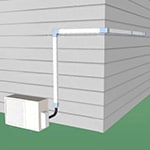
Mini Split Line Set Buyer's Guide
How to Choose the Perfect Mini Split Line Set
Mini split line sets function much like our arteries. Arteries connect vital organs in our body to help make life possible, and we would experience health issues with too low or too high of a blood pressure, or worse a leak!
In a mini-split system, line sets function the same, except instead of carrying oxygen and nutrients, they transport refrigerant that brings the heat into or out of our homes. Unless selected and installed properly, your air conditioning, heat pump, and mini split system will not work as designed.
Here’s what you need to know when choosing a refrigerant line set for a healthy mini-split system.

What's a Line Set and How Does it Work?
A refrigerant line set is simply a pair of copper tubes that connect a condenser to an evaporator. If you're not sure what those parts are, read our Air Conditioning 101 Guide. In the case of a mini-split system, the line set connects the indoor and outdoor units together, where the outdoor unit (condenser) supplies the indoor unit (evaporator) with refrigerant.
You'll notice in these sets that one line is larger than the other. That's because the smaller tube, the liquid or discharge line, carries dense liquid refrigerant to the evaporator where it can absorb heat. The larger tube, called the suction line, carries lighter, gaseous refrigerant back to the condenser where the heat can be ejected.
The refrigerant and vapor in the lines is continually recirculated in a loop to provide either heating or cooling depending on the direction of the flow. If your system has a heat pump feature, the flow is simply reversed to provide heating.
Single-Zone vs Multi-Zone Line Sets

Some multi-zone systems may require a branch box that is situated between the outdoor and indoor units and will require its own line set to connect to the outdoor unit.
Depending on the application, you may need a larger or smaller diameter line than the standard fitting you'll find on your unit. For these situations, your installer will use a port adaptor to make those connections, which may be included in your system.
Many people mistakenly think that these adapters will restrict the flow of refrigerant and are tempted to either modify the existing line to work or revert back to the “standard” sized line. However, these adapters will not restrict flow and will allow you to use the properly sized line regardless of the fitting size.
Always follow the manufacturer's recommendations for proper sizing of refrigerant piping connections.
Line Set Installation: Sizing
Mini split line sets come in different sizes based on multiple factors including the brand of mini split, number of indoor units, condenser size, and distance between units.
The list goes on, but you should always check your installation manual to get the proper sizing requirements for your particular system.
Diameter
Refrigerant line sets for mini splits are available in multiple, corresponding sizes, with the first number indicating the diameter of the liquid line and the second number indicating the diameter of the suction line.
For instance, a small (diameter) set contains a 1/4" liquid line with a 3/8" suction line. While a larger line set contains a 3/8" liquid line and 3/4" suction line.
Distance
When measuring the distance, be sure to take into account important factors such as bends and corners around the house, vertical rise, and thickness of the walls.
The last thing you want after you've already installed your system is to find out that the indoor unit is too far from the condenser and doesn't work properly because you've exceeded the maximum length requirement.
Refrigerant
The distance between units and the number of units also plays an important role with respect to the refrigerant in the mini split line set.
All mini-split systems come from the factory charged with refrigerant. This factory charge is often sufficient for the majority of installations, but if you are using longer AC line sets, your installer may need to add additional refrigerant to make sure your mini split operates properly.
The installation manual included with your system will contain complete details regarding when additional refrigerant is needed and how much must be added.
Quality Matters
You want your system to run trouble-free and at peak performance for years to come. That's why we source our refrigerant line sets from trusted manufacturers to make sure they're made to last.
Our line sets and accessories are made out of copper and manufactured to last longer due to a special heat-treating process called annealing that allows the metal to flex without kinking or breaking and are backed by a manufacturer warranty for up to five years.
They also feature flared ends for easier installation that don't require brazing, cutting installation time and costs. Finally, they come with at least 1/2" of insulation that is UL listed for weather resistance and is rated for smoke and fire, making them safer.
Another must-have accessory is a ball valve that makes servicing the refrigerant lines a breeze. Featuring a Schrader valve for quick charging, the ball valve allows the system to be serviced without having to evacuate all the refrigerant out of the lines, which is definitely a necessity for multi-zone systems.-->
Now that you know what line sets are, the next thing is knowing how to cover them to give your setup a complete and professional finish.
Mini Split Buyer's Guide Navigation
Home | Inverter Technology | Efficiency | Dehumidification | Heat Pumps vs A/C | Winterizing | Single-Zone vs Multi-Zone | How To Zone | Indoor Units | Accessories | Find an Installer | Mini Split Sizing Calculator | System Builder
